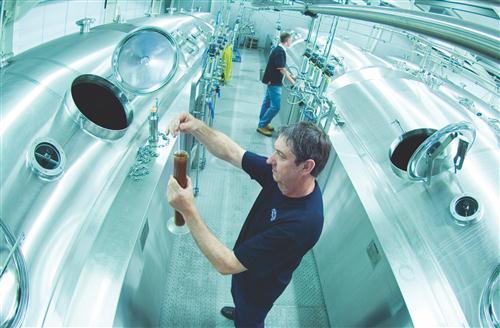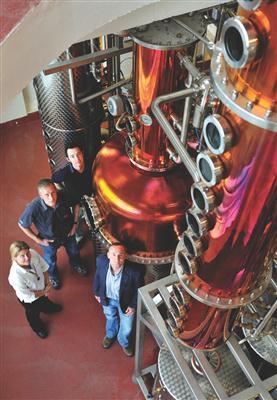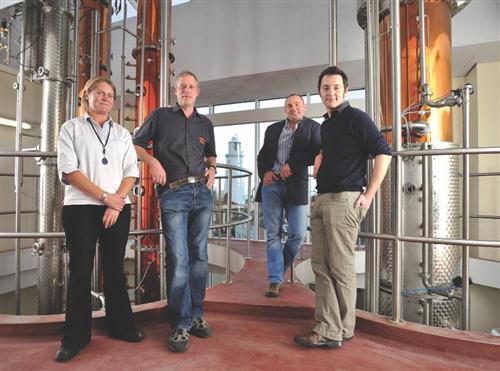THE ART OF BREWING

Inside Adnams Brewery.
Last year I wrote about “Brewing in East Anglia” with particular emphasis on the brewers in the CSCA area, both past and present. However, the two major brewers in Eastern England remain: Greene King in Bury St Edmunds; and Adnams in Southwold, and I turned to both of them to find out the processes used to brew a good pint.
After water and then tea, beer is the most widely consumed drink. There is evidence that beer was being brewed as long ago as 9500 BC when cereal was first farmed. However, the oldest chemical evidence of beer was found at a site in the Zagros mountains of Western Iran, suggesting a date of around 3500 BC to 3100 BC.

Yeast Vessels.
A beer-like beverage can be created from almost any substance that contains carbohydrates, mostly sugars and starch, which can undergo fermentation. Hence, beer is brewed around the world from maize, millet, sorghum and cassava root in Africa, potato in Brazil, and agave in Mexico, to name but a few.
The core ingredient of beer is barley that is tricked into germinating/growing by the maltster to produce malted barley or malt. The germination is started by steeping the barley in water whereby the stored polysaccharide or starch is broken down by natural barley enzymes into a range of smaller fermentable sugars which are extrated by the brewer to make beer. The malt is kiln dried to stop further growth and stabilise the grain.
These days, brewers buy the malted barley from specialist malsters rather than produce it themselves. At the maltings, the finished malt is screened, known as “dressing”, to ensure that the malt is sieved to a consistent size. Artefacts are removed except for stones of the same size, and dust is reduced. At the brewery, rotary screens are used to remove stones, and electro magnets ensure that any swarf or shards of metal, nuts or washers, do not reach the brewing process and therefore protect the mill.
As a rule of thumb, one tonne of malt makes 50 barrels of beer at 4% ABV. After screening, the brewer will mill the malted barley into a pre-determined particle size to produce crushed malt now known as “grist”. (The metaphor “adding grist to the mill” does not refer to this grist, but rather to corn, especially wheat, that from a time prior to the 1500s was known as grist and was taken to the mill to make flour and therefore profit!)
The brewing process (“mashing” from the name of the vessel “mash tun”) starts by mixing hot water at around 65°C, or around this temperature, depending on the type of finished beer, with the “grist”. The ratio of water to barley is one “noggin” to two “noggins”. Basically, this is merely a ratio of 2 to 1 of any sized receptacle.
The porridge like mixture is left to rest for an hour to ensure any residual starch is converted to fermentable sugars, as starch carry over can produce hazy beer. During this rest the sugars are dissolved to produce a sweet malt extract liquid called “wort” which is subsequently drained off the grains.
The grains are then washed, a process known as “sparging”, which ensures that the maximum amount of fermentable liquid is recovered. In modern breweries these two processes are combined and the liquid (“sweet wort”) is put in a “kettle” or “copper” where it is boiled for about an hour. The water evaporates but the sugars and other components of the “sweet wort” remain. At this stage, hops are added as a source of bitterness, adding flavour and creating an aroma, and the liquid becomes “hopped wort”.
The water used at Greene King is sourced from 3 artesian wells deep below the brewery. The water is abstracted, made potable and demineralised, to remove nitrates, before adding back mineral salts including gypsum to condition or harden the water. This process is known as “Burtonisation”. The name derives from Burton-on-Trent where the water is naturally hard, due to the presence of gypsum.
Having read this far you will realise that brewing has a wealth of strange words. The terminology for the next stage, is again rather quaint. After boiling, the “hopped wort “is cast into a whirlpool by use of a “tangenital feed”. The liquid spins or swirls which causes particulate matter to accumulate at the core at the base of the vessel. This forms “trub”, which is essentially spent hop material and protein which has come out of the solution during the boiling process. The now clear wort can be removed and is cooled on transfer to the fermentation vessel using cold fresh water which will be heated and used for subsequent brews. Brewing yeast is added and the process of fermentation begins.
The result of the fermentation process is to turn the “wort” into beer, a procedure that may take a week or more depending on the type of yeast and the desired strength of the beer. For every yeast cell that is used to inoculate the “wort” there is a fivefold increase by the end of fermentation. Much of the surplus is sold off. In the case of Greene King it is sent to make (you love it or hate it!) Marmite. Some is retained for use in future brews.
At the end of the fermentation the “green” beer is sent to package in casks, or cold conditioned at the brewery, before filtering and ultimately ending up in bottle can or keg. For the living beer in casks, finings or isinglass are added to aid settlement of residual yeast, leaving the beer bright.
The process of brewing is basically the same in all breweries. I was shown around the Greene King Westgate Brewery in May 2009. The present brewery was built in 1938, and remains authentic.
As a tower brewery, essentially the brewing process starts at the top of the building and, historically, gravity allows the production to drop from floor to floor, although conveyers and elevators do allow raw materials to be moved upwards/sideways as required. The end result at the base of the tower is the boiled and clarified hopped wort ready for fermentation. Greene King brew round about 500,000 barrels a year, or put another way, 155,000,000 pints!
Last Autumn I visited the Adnams Brewery in Southwold and found myself amazed at what a state of the art brewery looks like. In 2007 the company decided that the time had come to modernise. The old brewing equipment was second hand when it was installed in 1970 and was becoming a bit “tired”. The directors decided that the best brewing plant available, at the right price, for the size of operations, was from Huppmann in Germany. A plant was specifically designed to fit into the buildings on Victoria Street. The Fermentation part of the plant had already been updated and moved across the road, between 2001 to 2004, by Briggs of Burton-on-Trent. If you walk down Church Street you will pass what look like cottages with front doors, but behind these disguises is the brewery.

Computer control.
It was also designed to create an eco-friendly system as an imperative. Less water is used and some 90% of the heat is recycled. The end result is a stainless steel plant totally controlled from a computer.
In January 2012, I again visited the brewery, and met up with the Head Brewer, Fergus Fitzgerald, who is a young enthusiastic Irishman from Limerick. He learnt his trade at Fullers, having first thought that the dairy industry was to be his metier, but he found that the smell of cheese on a Monday morning was too much! Fergus joined Adnams when the new fermentation vessels for the brewery were being installed in 2004. The new brewhouse was then installed in 2007. Adnams brew around 86,000 barrels of beer a year.
The total brewing process is controlled from his desk, although he and his assistant brewers check the brew as it progresses. Whilst the malt is sourced from malsters, care is taken to purchase malted barley that originated in East Anglia, as this is considered to be the highest quality.

Fergus examining brew in progress.
When the brew reaches the mash tun filtration vessel, the temperature can be varied which allows greater diversity of the style of beer, or distillery wash, by careful control of the enzymatic action. The new brewhouse allows the brewers to use raw materials other than barley. Wheat beers, with wheat accounting for up to 60% of the sweet wort, have been produced, as well as 100% Rye distilling, for rye whisky. The wheat adds a spicy taste, with banana and clove flavours when used with the appropriate yeast.
After the brew is completed, the surplus spent grain is sent for cattle feed, as it contains lots of protein and fibre. Other surplus by-products are sent to the Adnams anaerobic digester, just outside the town, where the plant produces methane gas which is then fed into the mains gas pipeline, which in turn supplies the gas-fired boilers in the brewery.
At the final stage of the brewing process the liquid is boiled for sterilisation and to take in the hop flavours. Fergus has available up to twenty-one different varieties of hop, mainly English. The steam from this process is captured and passes through a heat exchanger to produce hot water to be used in the next brew, thereby saving energy costs of 30 to 35%. Once the beer is finished, it is piped to a cask filling plant on site. However, the beer to be bottled is taken by tanker to the Marstons Brewery in Burton-on-Trent and distributed centrally from there. The site in Southwold is not large enough to accommodate a bottling plant.
Adnams used to extract its water supply from boreholes under the brewery. However, in the early 1940s, it was found that salt water was seeping into the aquifer and the supply had to switch to the town’s mains water supply, which is used today. The water is purified before being “Burtonised”. The amount of water used to produce a pint of beer is approximately 3.2 to 1, whereas most breweries are more than 5 to 1.
Besides producing beer, Adnams installed, in 2010, a distillery to produce Gin, Vodka and Whisky. They are the only brewer in the UK to have a distillery on the same site as a brewery. The plant for the distillery came from Carl Artisan Distilleries in Germany.
The basic substance of any spirit is ethanol, which can be produced from the beer fermentation process. The brewing process follows the normal pattern but after the mashtun stage the liquid is not boiled and no hops are added and the liquid is passed into a fermentation vessel to ferment all the sugar to alcohol.
It then passes to a “beer stripper”, which is a tall boiling column some 20 feet high, The beer or wash from the fermenter, at 7% alcohol, is fed into this column where alcohols are evaporated and separated from the beer giving a liquid called ‘low wines’, which is approx. 80% ethanol. Thereafter, it passes into a pot still and then to two rectifying columns, again about 20 feet tall, which, by evaporation and condensation, produces the vodka quality spirit at 96/97% strength. This almost pure ethanol is then diluted down if it’s destined to be Vodka, or if it’s to be made into Gin it is left in a pot still overnight, along with some botanicals such as Juniper berries and orange peel, and distilled the following morning and then diluted to the required alcoholic strength. Whisky spirit is made by using ‘low wines’ and distilling them in the pot still.

Copper House Distillery.
If you are visiting Southwold, I would recommend that you set aside a couple of hours to go round the brewery. Tours depart from the Main Office on East Green alongside the brewery and bookings can be made by telephoning 01502 727225. The cost of a tour is £10 per person.
One thing that has really struck me, when visiting any parts of the Adnams brewery or the wine shops, has been the friendliness of the staff. This says a lot for the Directors and Managers. Furthermore, everyone seems to really enjoy working for the Company.

From left to right: Belinda Jennings (Quality Assurance Manager), John McCarthy (Head Distiller), Jonathan Adnams (Chairman) and Fergus Fitzgerald (Head Brewer).
Whilst Gin and Vodka are on sale, the Whisky has yet to be bottled as it has to be matured in Oak casks for a minimum of three years to qualify as whisky, and the first batch was only distilled in 2010.
Adnams have diversified over recent years and now have a chain of Cellar and Kitchen shops, which have an extremely good range of kitchen utensils and an outstanding selection of sensibly priced wines. In the CSCA locality there is a shop in Hadleigh, which I can recommend. I am grateful to Fergus for correcting the content of this article, where it relates to Adnams, and also, Jonathan Adnams for giving the article one final check. I am also grateful to John Bexon, of Greene King, for his guidance in relation to the brewing processes and the unique names used.
Mark Dawson
Distillery photographs by Anthony Cullen.
